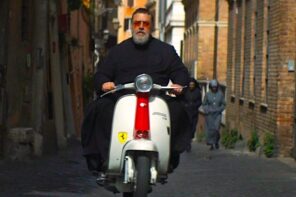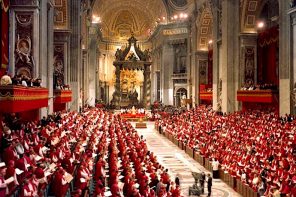As white smoke pours out of the Vatican smokestack, it’s safe to say the face that emerges from the fog will soon also grace the cover of Time. Just under the wire for Holy Week, the traditional season of religiously-themed magazine covers, the new pontiff is sure to be seen in a gleaming soutane, his arms outstretched, suitable for framing within the red border that once announced a moment the world would stop to notice. In their former ubiquity, their former authority, the former certainty of the futures of their respective empires, the pope and Time seem made for each other.
The first time Time put a pope on its cover—June 16, 1924—it tried to split the difference between the era’s rampant anti-Catholicism and the “Great Man” narratives that were then its stock and trade. Beneath an illustration depicting Pope Pius XI as bespectacled, human, and approachable (literally soft around the edges, thanks to the artist’s light touch), there appeared words offering a decidedly more ominous message: “No Popery!”
Only after reading beyond this initial interplay of image and text would readers wonder if there had been a bait-and-switch. The cover caption referred to words appearing in the related article, in which “No Popery” was quoted as a cry often heard in England a full a century before. Provocative on the cover, the caption was shown to be an archaism on the pages within. By the end of the article, readers found Pius XI described favorably as “a Pontiff who permits baseball to be played in the Vatican grounds and who enjoys watching the game from his window.”
The ambivalent relationship between the leader of the Roman Catholic Church and the American media has continued ever since. There is no other job opening on Earth that would receive so much attention—despite, or maybe due to, the fact that many prominent journalists are openly hostile to the teachings of the Church.
Much of this is the legacy of the man who boldly put both a pope and “popery” on the cover of his magazine almost ninety years ago: a Protestant missionary’s son who found himself in bed with the Church in more ways than one. For Henry Luce, there was of course the actual Catholic with whom he shared his home, his second wife Clare Boothe Luce, but there was also an unabashed affinity for the Olympian authority the Vatican represented—similar to the kind he imagined his publications would offer each week. As one of his early biographers noted, Luce “respected anybody who took a traditional religion seriously, whether Presbyterian, Roman Catholic, or Orthodox Jew, and deplored Unitarians, lapsed Catholics, and Reformed Jews.” His magazine followed suit, with little use for rabble-rousers or supposed diluters of truth.
Putting Catholic clergymen on the cover became a common trope for Time. After Pius XI, its next Catholic cover had the dual distinction of being the first to depict an American churchman (George Cardinal Mundelein, archbishop of Chicago) and the first to include color in the form of an eye-catching orange bar down the left side of the page. With such covers, which included three others cardinals and two additional images of the pope in the magazine’s first fifteen years, Time put faces to the Catholic hierarchy as never before. Other publications of the day often featured cartoons of the “Roman menace” in the spirit of Thomas Nast’s infamous tooth-hatted bishops crawling like crocodiles onto American shores, but Luce framed his Catholic cover subjects within a week-to-week serial of significant individuals of whom lesser mortals should take note. When one of his cover-cardinals, Eugenio Pacelli, eventually became Pope Pius XII, Time could claim status not merely as Catholic observer, but Catholic kingmaker as well.
Readers hoping to gain insight into what it actually might mean to live as an American Catholic who was not a member of the clergy were better served elsewhere. Through much of its history, Time’s blind spot to certain kinds of Catholic stories was compensated by its sister publication, which came to being at the suggestion of Clare Boothe Luce. Perhaps one of the most influential Catholic converts in American history, she had learned the faith at the knee of Bishop Fulton J. Sheen, and counted among her friends the bestselling author and monk Thomas Merton. She persuaded Luce to transform their seven-thousand acre South Carolina estate into a Trappist monastery (where they both were later buried), and likewise convinced him to break new ground with the first national magazine of photojournalism.
From its start in 1936, Life offered a very different take on the place of religion in America. While Time’s religious coverage moved within an orbit held by the gravity of authority, Life offered glimpses of religion as it was lived.
The magazine’s first Catholic cover showed a nun bent over an industrial-sized kitchen bowl, kneading a ball of dough so large it seems she might lose an arm. Over the caption “Franciscan retreat,” the image forecasts that Life’s Catholic coverage would differ from Time’s in a number of ways. First and most obviously, it depicts a woman; second and perhaps less so, it depicts work. The lives of Catholics, the picture says, do not require the stillness or the clerical luxury depicted in many of Time’s cover images of prelates and popes. Life’s cover images of lived-religion would continue with the then-famous Dionne sisters (the first known quintuplets to survive infancy) as they prepared for their First Communion in 1940, depictions of a Catholic baptism in the 1950s, and a Catholic wedding in the 1960s.
Life also offered image-driven coverage of institutional Catholic events like the Second Vatican Council and the papal elections of John XXIII and Paul VI. With its focus on visual storytelling, Life was able to make human interest stories of events Time covered as “world affairs.” Only Life made mention of what the bishops ordered for dinner when Vatican II’s sessions overflowed to Roman restaurants. Despite the spread of sole, bass, and shrimp on display in one Life photograph, the caption noted that the picture was taken on a Wednesday, so the bishops chose steak.
Ultimately, Life would offer far fewer Catholic cover images than Time, but those it did feature suggested that Catholic lives were also family lives, sacramental lives, and American lives—regardless of one’s position within the Church. It was a side of the Catholic experience left untold by the covers of Time, and if not for Life’s end in the 1970s, we might now be the beneficiaries of a fuller expression of the faith in the media.
Or perhaps not: Differences of approach aside, Time and Life nonetheless told Catholic stories with similar relationship to authority. The notion that a religious organization as large as the Catholic Church might naturally include internal dissent was for the most part beyond the newsweeklies’ narratives of Catholicism in America, at least through the first four decades of publication. Only with the shifting cultural sands of the 1960s and early ’70s did Time’s Catholic covers diverge from this script. It did so not for any change of heart about the primacy of authority in its coverage of religion, but in answer to a marketplace challenge.
Thanks to their enormous popularity, Luce’s publications had their share of imitators. None came close to testing the dominance of Time until one would-be rival was bought by the Washington Post Company in 1961. Newsweek had been founded by an ex-Time staffer almost thirty years before, and perhaps as a filial rejection of a former employer’s concerns, in the beginning Newsweek published very little about religion generally, and less about Catholics specifically. It featured the pope on its cover only at those unignorable moments such as the death of Pius XI in 1939, and the election of Pope John XXIII nine years later. (The 1939 election of Pius XII did not warrant a cover in Newsweek’s estimation.)
The advent of the 1960s, and the magazine’s new status as subsidiary of the Post, led Newsweek to take a different approach. With the 1963 cover story “Catholicism in America” and 1967’s “How Do Catholics View Their Church?” it seemed coverage of the Church in national newsweeklies had moved away from the top-down approach.
When Time began to tell similar stories of fracturing faiths and tested authority, it may have been as much due to the times as to the fact that Luce had died in 1967. Not long after Newsweek changed the unwritten rules of how the Church might be covered, Time offered “The Catholic Exodus: Why Priests and Nuns are Quitting,” its first cover article using a woman, in the figure of a former nun, to illustrate a story about the Church. A year later, Time again entered the fray of religious controversy with a cover featuring “Rebel Priests” Phillip and Daniel Berrigan, the anti-Vietnam activists serving federal prison sentences for burning draft cards with napalm.
Not to be outdone, Newsweek brought out an issue with the words “Has the Church Lost Its Soul?” emblazoned on its cover. Taken together, the Time and Newsweek Catholic stories of the late 1960s and early 1970s suggest that, after nearly a half-century, the newsweeklies’ tendency to affirm the power of the Church had given way to boldface questioning of its unity, legitimacy, and relationship to civil authority.
After the 1960s the newsweeklies cut back on coverage of all religion, and Catholic coverage was no exception. Treatment of the Church fell through the 1970s, and did not pick up again until the drama of the decade’s end, when 1978 brought the year of three popes. The deaths of Paul VI and John Paul I provided opportunities for coverage much like Time had offered decades before.
And then came the clergyman the newsweeklies seemed born to cover. A former actor and athlete, charismatic, indefatigable and handsome, Pope John Paul II may have been an unknown quantity to many in the Church, but he was an immediate hit on the newsstand. Excluding U.S. presidents, Pope John Paul II earned more Time covers than anyone—fourteen in eighteen years. Newsweek was similarly swayed. Describing John Paul II in 1979, covers of the two magazines differed only on matters of grammar: while Newsweek spoke of his “triumph”, Time praised his “triumphal return.” In return, he provided both with endless opportunities to feature the kinds instantly iconic images upon which newsweeklies had been built.
As wholeheartedly as Time and Newsweek endorsed the “triumph” of John Paul II, the weeklies’ born-again fondness for religious authority has not endured until today. Since the explosion of the clergy sex abuse scandals in the media, a curious trend has emerged on the covers of news magazine. In four Time covers—April 1, 2002, November 27, 2006, June 7, 2010, February 25, 2013—the familiar figure of the pope appears, but altered. Unlike the scores of previous covers featuring the Bishop of Rome, the pope now stands either with his back to the reader, or in the case of a cover depicting Benedict XVI on the eve of retirement, with his features shrouded in darkness. Where once the face on the magazine cover was all, here were four images in which the pope was literally de-faced. The Church and the American media may once have found common purpose in telling stories of great men made into icons on the covers of the news magazines, but today much of the reading public seems more interested in iconoclasm.
When the new pope is soon shown within Time’s familiar red frame he will likely appear in full and flattering light, but only briefly. Is it any wonder that the last newsweekly standing would gravitate toward stories of once-unquestioned authority undermined and reduced to a shadow of its former significance? This is, after all, a story it knows quite well.
*This essay was adapted from a chapter in The Oxford Handbook of Religion and the American News Media.




